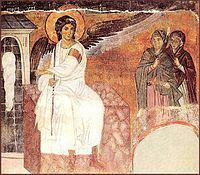Created 1235 | ||
 | ||
Similar Angel of Grief, Trojeručica, Annunciation, Kosovo Maiden | ||
White angel christmas origami paper angel 3d
White Angel (Serbian: Бели анђео / Beli anđeo) is a detail of one of the best known frescoes in Serbian culture in the Mileševa monastery, Mironosnice na Hristovom grobu (Myrrhbearers on Christ's Grave), dated c. 1235 in Serbia during the reign of King Stephen Vladislav I of Serbia. Considered one of the most beautiful works of Serbian and European art from the High Middle Ages, this fresco is considered to be one of the great achievements in European painting. It depicts the arrival of the myrrhbearers at the tomb of Christ on Sunday morning, after the events of the Crucifixion. Sitting on the stone is the Angel of the Lord dressed in a white chiton, whose myrrh-bearing arm shows the place of Christ's resurrection, and his empty tomb.
Contents
The fresco is located on the southern wall of the church and the identity of its author is unknown. In the 16th century, the White Angel was over-painted with another fresco, and so was hidden until the 20th century when the fresco was restored.
A picture of the White Angel of Mileševa was sent as a message in the first satellite broadcast signal from Europe to America after the Cuban Missile Crisis, as a symbol of peace and civilization. Later, the same signal, containing the White Angel, was transmitted to space in an attempt to communicate with extraterrestrial life forms.
